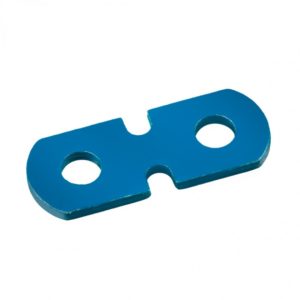Advantage of Lug-All Overload Protection: Extra Stress Links
 Every Lug-All Web Strap Come Along Ratchet Winch Hoist is equipped with a handle socket design that incorporates a stress link for overload protection. This stress link will break when overloaded to protect you and your hoist, and if you’ve ever purchased a new Lug-All Web Strap Hoist, you probably noticed the two replacement stress links attached to the handle. Even though those two small parts might seem unimportant at first, the stress link socket assembly is one of the most important safety features of a Lug-All Web Strap Hoist, so the extra stress links should always be kept with the socket assembly. If the stress link on your hoist breaks, you’ll be happy to have a replacement on hand.
Every Lug-All Web Strap Come Along Ratchet Winch Hoist is equipped with a handle socket design that incorporates a stress link for overload protection. This stress link will break when overloaded to protect you and your hoist, and if you’ve ever purchased a new Lug-All Web Strap Hoist, you probably noticed the two replacement stress links attached to the handle. Even though those two small parts might seem unimportant at first, the stress link socket assembly is one of the most important safety features of a Lug-All Web Strap Hoist, so the extra stress links should always be kept with the socket assembly. If the stress link on your hoist breaks, you’ll be happy to have a replacement on hand.
Why It’s There
You should never load any hoist over its maximum capacity, but that doesn’t mean overloading can’t happen accidentally. By snapping when your Lug-All Web Strap Hoist is overloaded, the stress link prevents the load-bearing parts and the fiberglass handle from becoming overloaded enough to fail. If the stress link breaks, the overload link holds the handle assembly together to allow you to back off the load and remove the hoist from operation. After the hoist is removed, the broken stress link can be replaced with a new one, and you can continue using it normally. As long as your hoist has both a functional stress link and an overload link in the socket assembly, you know that you and your equipment will be safe if you accidentally overload it.
Why It Needs to Be Replaced
It’s important to remember that the socket assembly on a Lug-All Web Strap Hoist only offers overload protection when the stress link is intact. For your hoist to continue to protect you from overload danger, the stress link must be replaced immediately when it breaks. After the stress link breaks, the handle assembly is held together only by the overload link. The overload link can endure a much higher overload force because it is designed to keep the hoist functional under a load great enough to break the stress link, which is why not replacing your stress link can become dangerous.
The stress link is designed to break at 125 percent of the hoist’s maximum capacity, which means it will break before any critical structural parts of the hoist—the hooks, the pawl, the frame, etc.—reach their breaking point. The overload link is not designed this way. If a handle assembly only has the overload link, you will not know if an overload condition exists. The hoist can easily become more and more overloaded until one of the essential parts can no longer bear the weight, meaning the hoist could fail catastrophically, resulting in severe damage to your hoist, or worse, serious injury to the operator or any person nearby.
Keep Your Extra Stress Links
As we mentioned at the beginning of this blog, every new Lug-All Web Strap Hoist comes with two replacement stress links. That means you already have all the parts you need to return your hoist to safe working condition if the stress link ever breaks. You won’t spend money ordering a new part or leave your hoist out of operation while you wait for it to arrive. With two 7/16 box wrenches to remove the threaded link pins and nuts, replacing the stress link on your Lug-All is fast and easy; in fact, a lineman working in a bucket truck can replace a broken link without leaving the bucket. By keeping your replacement links with your hoist and following this step-by-step guide, you can return your hoist to operation right away. Save yourself time and money without sacrificing safety—always keep the extra stress links for your Lug-All Web Strap Hoist.
Remember: no amount of safety features can protect a person who decides to act recklessly. It is the user’s responsibility to use any hoist in a safe manner by always following the manufacturer’s instructions for correct use.
